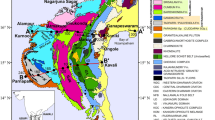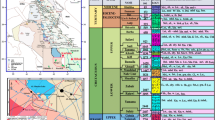Abstract
Structural features of the typical continental paleorift in Panxi area are revealed by seismic tomography. (1) In the profile along the minor axis of Panxi paleorift, we found alternating high and low-velocity strips existing at different depths in the crust, presenting itself as a “sandwich” structure. The existence of these high and low-velocity anomaly strips is related to the basal lithology in the rift area. (2) An addition layer with velocity values of 7.1-7.5 km/s and 7.8 km/s exists from the base of lower crust to uppermost mantle and its thickness is about 20 km. Some study results indicate that the addition layer results from the invasion of mantle material. (3) A lens-shaped high-velocity body surrounded by relatively low-velocity material is observed at depths of 110-160 km between Huaping and Huidong in the axis of the paleorift. This is the first time to discover it in the upper mantle of the paleorift. Based on the results of geology, petrology and geochemistry, we infer that the formation of the addition layer and the lens-shaped high-velocity body in the upper mantle are related to the deep geodynamic process of generation, development and termination of the rift. On the one hand, the upwelling of asthenosphere mantle caused partial melting, and then the basaltic magma from the partial melted material further resulted in underplating and formed the crustal addition layer. On the other hand, the high-density content of mineral facies was increased in the residual melted mass of intensely depleted upper mantle, formed by basalt withdrawing. The solid-melt medium in the depleted upper mantle was mainly an accumulation of garnet and peridotite because the heating effect of lithosphere was relatively weakened in the later riftogenesis, so that a lens-shaped high-density and high-velocity zone was produced in the upper mantle. The results indicate that the energy and material exchange between asthenosphere and lithosphere and remarkable underplating would have an important effect on the material state and propagation of seismic wave in the lower crust, crust-mantle interface, asthenosphere and lithosphere. This process possibly is an important mechanism on the growth of continental crust and the evolution of deep mantle.
Similar content being viewed by others
References
Neumann, R. E., Rift zones in the continental crust of Europe-geophysical, geological and geochemical evidences Olso-Horm graben, Tectonophysics, 1990, 178: 1.
Remberg, I. M., Milanovsky, E. E., Qvale, G., Continent rifts, principle and regional characteristics, Tectonophysics, 1987, 143: 1.
Morgan, P., Sengor, W. R., Golomberk, M. P., Cenozoic thermal, mechanical and tectonic evolution of the Rio Grande rift, J. Geophys. Rev., 1986, 91: 6263.
Olsen, K. H., Continental Rifts: Evolution, Structure, Tectonics, tAmsterdam: Elsevier Science B. V., 1995.
Lobkovsky, L. I., Ismail Zadeh, A. T., Krasovsky, S. S. et al., Gravity anomalies and possible formation mechanism of the Dnieper-Donets basin, Tectonophysics, 1996, 268: 281.
Anderson, D. L., Theory of the Earth (in Chinese), translated by Guan Huaping, Yang Yurong, Liu Xiaowei et al., Beijing Seismological Press, 1993.
Cong Bolin, The Formation and Evolvement of Panxi Paleorift (in Chinese), Beijing: Science Press, 1988.
Pan Xingnan, Kang-Dian Structure and Rifting (in Chinese), Chongqing: Chongqing Press, 1987.
Huang Kainian, Yang Ruiying, Wang Xiaochun et al., A preliminary study on trace element geochemistry of Emeishan basalts from SW China, Acta Petrologica Sinica (in Chinese), 1988, (4): 49.
Shen Fakui, Geochemical evidence for the petrogenesis of volcanic rocks in the Panzhihua-Xichang ancient rift, Geochimica (in Chinese), 1989, (2): 158.
Teng Jiwen, Lithospheric Physics and Dynamics in Kang-Dian Tectonic Belt (in Chinese), Beijing: Science Press, 1994.
Xiong Shaobai, Teng Jiwen, Yin Zhouxun et al., Explosion seismological study of the structure of the crust and upper mantle at southern part of the Panxi tectonic belt, Acta Geophysica Sinica (in Chinese), 1986, 29(3): 235.
He Qixiang, Wang Dongpo, Liu Zhaojun et al., Sedimentary facies and paleogeography of the Late Triassic Bingnan Formation in Panxi rift belt, Collected Works on Panxi Rift (1) (ed. Zhang Yunxiang) (in Chinese), Beijing: Geological Press, 1985, 258–274.
Tang Ruolong, Yang Dengwen, Liu Shuqian et al., Dual structural feature from extension to compression in the Panxi paleorift southwest of Sichuan, Collected Works on Panxi Rift (1) (in Chinese) (ed. Zhang Yunxiang), Beijing: Geological Press, 1985, 71–86.
Cui Zuozhou, Lu Deyuan, Chen Jiping et al., The deep structural and tectonic features of the crust in Panxi area, Acta Geophysica Sinica (in Chinese), 1987, 30(6): 566.
Lu Deyuan, Cui Zuozhou, Huang Liyan et al., The crustal structure of Lijiang-Xichang-Xinshizhen region in the north part of Kang-Ding S-N tectonic belt, Collected Works on Panxi Rift (3) (eds. Zhang Yunxiang, Yuan Xuegeng) (in Chinese), Beijing: Geological Press, 1988, 22–35.
Lu Deyuan, Cui Zuozhou, Chen Jiping et al., A study on explosion seismic sounding of the crust at Dukou-Kangding region, Collected Works on Panxi Rift (3) (eds. Zhang Yunxiang, Yuan Xuegeng) (in Chinese), Beijing: Geological Press, 1988, 36–45.
Zheng Jianzhong, Xu Wenyue, Liu Jin et al., Some characteristics of the seismicity and the stress field in Panxi rift zone, Collected Works on Panxi Rift (3) (eds. Zhang Yunxiang, Yuan Xuegeng) (in Chinese), Beijing: Geological Press, 1988, 172–184.
Luo Yaonan, Panzhihua-Xichang palaeo-rift zone, China, Collected Works on Panxi Rift (1) (ed. Zhang Yunxiang), Beijing: Geological Press, 1985, 1–25.
Liu Jianhua, Liu Futian, Wu Hua, Three dimensional velocity images of the crust and upper mantle beneath north-south zone in China, Acta Geophysica Sinica (in Chinese), 1989, 32(2): 143.
Artyushkov, E. B., Baer, M. A., Letnikov, F. A. et al., On the mechanism of graben formation, Tectonophysics, 1991, 197 99.
Keller, G. R., Lidiak, E. G., Hinze, W. J. et al., The role of rifting in the tectonic development of the midcontinent, U. S. A., Tectonophysics, 1983, 94: 392.
Tang Lianjiang, Rift and rifting, The Basic Problems of Plate Structure (eds. Li Chunyu, Guo Linzhi) (in Chinese), Beijing Seismological Press, 1986, 34–62.
Liu Congqiang, Xie Guanghong, Akimasa Masuda, Geochemistry of Cenozoic basalts in East China—Composition of host- and micro-elements: Rock genesis and feature of source area, Geochimica (in Chinese), 1995, (1): 1.
Sumino, Y., Anderson, D. L., Elastic constants of minerals, in Handbook of Physical Properties of Rocks, V. 3, Florida CRC Press, 1984, 39–138.
Lu Songnian, Yang Chunliang, Jiang Mingmei et al., Evolvement Trace of the Precambrian Continental Crust (in Chinese), Beijing: Geological Press, 1986, 72–84.
Zhao Zhenhua, The Geochemistry Principle of Microelement (in Chinese), Beijing: Science Press, 1997, 7–48.
Furlong, K. P., Fountain, D. M., Continental crustal underplating, thermal consideration and seismic-petrologic consequences, J. Geophys. Res., 1986, 91(B8): 8285.
Zhong Dalai, Ding Lin, A study on upwarping process and mechanism in Qinghai-Tibet plateau, Science in China (in Chinese), Ser. D, 1996, 26 (4): 289.
Quick, J. E., Emplacement dynamics of a large mantle intrusion in the lower crust, Ivreaverbano zone, Northern Italy, J. Geophys. Res., 1994, 99(B11): 21559.
Rudnick, R. L., Fountian, D. M., Nature and composition of the continental crust: A lower crustal perspective, Rev. Geophysics, 1995, 33: 267.
Liu Jianhua et al.: Study of seismic tomography in Panxi paleorift area of southwestern China Plate I
Author information
Authors and Affiliations
Corresponding author
Rights and permissions
About this article
Cite this article
Liu, J., Liu, F., He, J. et al. Study of seismic tomography in Panxi paleorift area of southwestern China. Sci. China Ser. D-Earth Sci. 44, 277–288 (2001). https://doi.org/10.1007/BF02882262
Received:
Issue Date:
DOI: https://doi.org/10.1007/BF02882262




